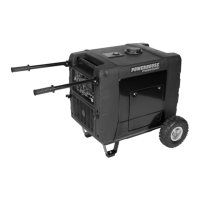
Do you have a question about the Powerhouse PH6500Ri and is the answer not in the manual?
| Type | Inverter Generator |
|---|---|
| Fuel Type | Gasoline |
| Run Time at 50% Load | 10 hours |
| Starting System | Electric Start |
| Inverter | Yes |
| Parallel Capability | Yes |
| Rated Power | 5500 W |
| Surge Power | 6500 Watts |
| Engine Type | 4-Stroke |
| DC Output | 12V / 8.3A |
Identifies key external components of the generator, including handles, control panel, and tires.
Details the generator's control panel, labeling all buttons, indicators, and receptacles for operation.
Explains where to find the unit's serial and bar code numbers for warranty and parts ordering.
Step-by-step guide for checking and refilling the engine oil level using the dipstick.
Guidance on checking the fuel level using the mechanical gauge or digital display before operation.
Steps to inspect, clean, or replace the air cleaner element for optimal engine performance.
Procedure for connecting the generator's internal battery wiring harness before initial use.
Step-by-step instructions for safely removing and replacing the generator's battery.
General information on starting the generator using the ignition key or remote control.
Detailed steps for starting the engine using the physical ignition key.
Instructions for starting the engine remotely using the key fob.
How altitude affects generator performance and potential adjustments for optimal operation.
Guidance on operating the generator safely in very hot or very cold ambient temperatures.
Essential safety and operational guidelines, including grounding, placement, and load management.
How to select and use the generator for 120V-only or 120V/240V output modes.
Explanation of the parameters and information shown on the generator's LCD display.
How AC power is supplied through receptacles and how to connect appliances safely.
What happens during an overload, how indicators display it, and how to reset the generator.
How the generator protects appliances from low voltage and how to restore power.
Using the DC receptacle to charge batteries or power 12V DC devices.
How the low oil alarm prevents engine damage and what to do if it activates.
How the economy switch affects fuel consumption and engine speed.
Procedures for safely shutting down the generator in normal and emergency situations.
Guidance on powering RV air conditioners with the generator.
Information on the generator's emission control system and its components.
A schedule outlining required maintenance tasks and recommended intervals for optimal performance.
Step-by-step instructions for draining and refilling the engine oil safely.
How to clean or replace the air cleaner element for optimal engine performance.
Procedure for inspecting, cleaning, gapping, and replacing the spark plug.
Steps for cleaning or replacing the spark arrester to maintain engine efficiency.
Safety precautions and procedures for securely transporting the generator.
Guidelines for storing the generator properly for short periods to prevent issues.
Detailed instructions for preparing the generator for long-term storage or infrequent use.
Importance and method of regularly running the generator to maintain its condition.
A flowchart to diagnose and resolve common problems when the engine fails to start.
Steps to troubleshoot why the engine does not crank using the start controls.
Steps to troubleshoot why a connected appliance is not receiving power.
Diagnosing and resolving problems with the generator's DC output receptacle.
Steps to take when the digital display is on but shows no operational information.